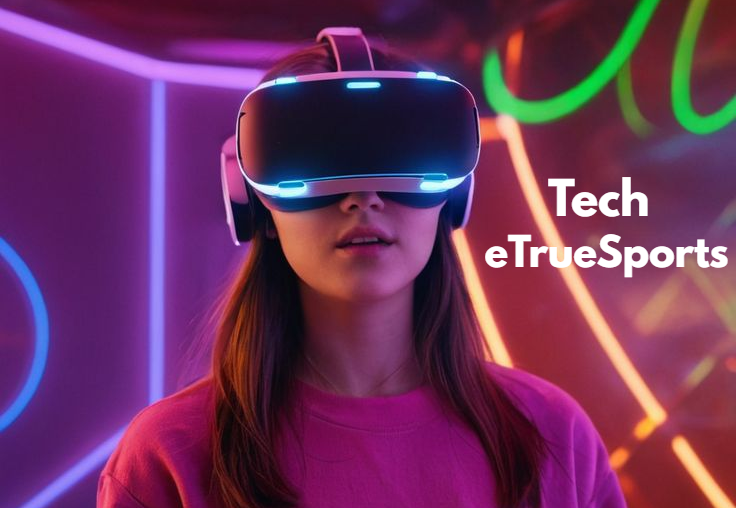The world of sports is evolving, and technology plays a vital role in its transformation. From real-time data analytics to virtual sports, the integration of tech into traditional athletic pursuits has revolutionized the industry. One of the most exciting developments in this space is eTrueSports—a blend of esports and real-world sports experiences enhanced by cutting-edge technology. In this article, we explore how technology is reshaping the sports landscape, with a focus on eTrueSports, and how this new category of competitive virtual sports is captivating audiences around the globe.
What is eTrueSports?
eTrueSports refers to the emerging world where real sports and esports intersect. Unlike traditional esports, which involve video games that simulate sporting events, eTrueSports blends real-world sports elements with digital enhancements. This new genre leverages advanced technologies such as virtual reality (VR), augmented reality (AR), artificial intelligence (AI), and wearable sensors to create immersive, interactive experiences that combine physical and virtual competition.
eTrueSports provides an opportunity for athletes, sports enthusiasts, and casual fans to engage with sports in a dynamic, tech-enhanced environment. This hybrid form of competition bridges the gap between physical athleticism and virtual skill, creating a new level of excitement and engagement for participants and spectators alike.
The Role of Technology in eTrueSports
Technology is the backbone of eTrueSports. Advanced hardware and software allow for an immersive, realistic experience that combines the best aspects of traditional sports with cutting-edge virtual environments. Let’s take a closer look at the technologies driving eTrueSports:
1. Virtual Reality (VR)
Virtual reality is a game-changer for eTrueSports. It allows players to enter immersive environments where they can participate in sports events that feel as real as the physical world. Whether it’s a basketball game in a simulated stadium or a tennis match on a virtual court, VR creates an unparalleled level of engagement.
With the use of VR headsets, players can interact with their surroundings, move within the game space, and experience the thrill of competition from anywhere in the world. This also allows for training simulations, where athletes can practice and refine their skills in a realistic setting without the need for physical equipment or venues.
2. Augmented Reality (AR)
Augmented reality enhances real-world environments with digital overlays, making it another key technology in the eTrueSports experience. AR allows athletes to interact with both the physical and digital worlds simultaneously, creating opportunities for more dynamic gameplay. For instance, AR could be used in real-world sports events to display additional information, such as player stats or tactical insights, in real-time.
AR applications can also be used for training purposes, offering players a digital layer of guidance and feedback while they practice in a physical space. This combination of real-world action and digital enhancement helps to improve performance and make training more efficient.
3. Wearable Sensors and Smart Devices
Wearable sensors and smart devices have become essential tools in modern sports, and their impact on eTrueSports is equally significant. These devices collect real-time data on athletes’ performance, such as heart rate, speed, and movement. This data is then analyzed to provide insights that can be used to improve performance, strategize gameplay, and enhance the overall experience.
In eTrueSports, wearable tech can monitor players’ physical efforts while they compete in virtual sports, allowing for a hybrid competition that blends physical and digital elements. For example, a soccer player could wear smart sensors that track their movements in real life, while those movements are translated into actions within a virtual soccer match.
4. Artificial Intelligence (AI) and Data Analytics
AI and data analytics are crucial for driving the competitive nature of eTrueSports. AI can be used to create virtual opponents that learn and adapt to a player’s strategies, making gameplay more challenging and realistic. Additionally, AI is used in the analysis of player performance, providing insights that can help athletes refine their skills and make smarter decisions during competition.
Data analytics allows players and teams to break down their performances in real-time. Coaches, analysts, and players can use this information to make informed decisions about tactics and strategies, improving the overall quality of the game. This level of analytics is already common in professional sports, and its integration into eTrueSports enhances the virtual experience by making it more competitive and data-driven.
How eTrueSports is Changing the Sports Landscape
eTrueSports is not just a niche category within the gaming world—it’s revolutionizing the way people experience sports. Here are several ways in which eTrueSports is making waves in the broader sports industry:
1. Blurring the Line Between Real and Virtual Sports
The line between traditional sports and virtual sports is becoming increasingly blurred, thanks to the rise of eTrueSports. Athletes who compete in physical sports are now also participating in virtual sports events, often within the same space. This creates new opportunities for fans to engage with their favorite athletes in both real and virtual settings, adding another layer of excitement to the sports-watching experience.
Fans can follow their favorite athletes in both physical and virtual arenas, attending VR or AR-enhanced matches that provide an entirely different way to experience sports. This fusion of reality and virtuality brings a new level of immersion that wasn’t possible before.
2. Global Reach and Accessibility
One of the most significant advantages of eTrueSports is its global accessibility. Traditional sports are often limited by geographical boundaries, but eTrueSports eliminates these constraints. Players and fans from around the world can participate in or watch events, regardless of location. This has created a global community of sports enthusiasts who can engage with their favorite games and athletes from anywhere in the world.
Additionally, eTrueSports makes sports more accessible to individuals who may not have the physical capability to participate in traditional sports. With VR and AR technologies, people with physical disabilities can compete in virtual versions of their favorite sports, creating a more inclusive sports landscape.
3. New Opportunities for Sponsorship and Monetization
The rise of eTrueSports has opened up new opportunities for brands and sponsors to reach a highly engaged audience. As the popularity of virtual sports continues to grow, brands are looking for ways to connect with the tech-savvy, digitally native demographic that follows eTrueSports. This has led to innovative sponsorship deals, partnerships with tech companies, and new avenues for monetization, such as virtual merchandise and in-game advertising.
In addition to traditional sponsorship models, eTrueSports also offers opportunities for monetization through streaming platforms. Players and teams can build their own brands by broadcasting their games and competitions on platforms like Twitch and YouTube, attracting large audiences and generating revenue through ads, donations, and subscription services.
The Future of eTrueSports
As technology continues to evolve, so too will eTrueSports. The future of this emerging sports category looks incredibly promising, with several exciting developments on the horizon:
1. Advanced VR and AR Experiences
As VR and AR technologies continue to improve, the eTrueSports experience will become even more immersive. Future advancements could include haptic feedback systems that allow players to physically feel the impact of the game, or full-body tracking that mirrors a player’s real-world movements in the virtual environment. These developments will make virtual sports feel even more real, enhancing the overall experience for both players and spectators.
2. Increased Integration with Traditional Sports
We can expect to see even more integration between traditional sports and eTrueSports in the future. Professional sports leagues may begin to incorporate virtual sports events into their schedules, offering fans a new way to engage with the sport. For example, an NBA team might host a virtual reality basketball tournament for fans in conjunction with a live game, allowing viewers to experience the action in a completely new way.
3. Cross-Sport Competitions
One of the most exciting possibilities for the future of eTrueSports is the potential for cross-sport competitions. Players from different sports could compete in a hybrid format that blends elements of their respective games into a new, virtual sport. For example, a basketball player could go head-to-head with a soccer player in a VR game that combines both sports, creating a unique and thrilling competition.
4. Greater Fan Engagement and Interaction
Technology will continue to enhance fan engagement in eTrueSports, offering new ways for audiences to interact with the game and the players. Fans could have the opportunity to participate in virtual games as part of the competition, or they might be able to influence the outcome of a match through real-time voting or interaction. This level of engagement will deepen the connection between fans and the game, making eTrueSports a more interactive and participatory experience.
Conclusion
eTrueSports is at the forefront of the sports revolution, merging the worlds of traditional athletics and esports through cutting-edge technology. With innovations in VR, AR, AI, and wearable tech, eTrueSports is creating a hybrid sports experience that combines physical activity with virtual competition. As the industry continues to grow, eTrueSports is poised to become a major force in the future of sports, offering fans, athletes, and brands new opportunities to engage with the games they love.
Whether you’re a traditional sports fan or an esports enthusiast, the exciting world of eTrueSports provides something for everyone. As technology continues to evolve, the boundaries between real and virtual sports will continue to blur, creating a dynamic and immersive sports experience unlike anything we’ve seen before.


